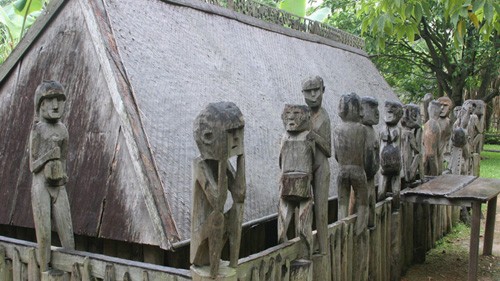(VOVworld) –Ede sculpture is exemplified in houses, graves, and pillars. The designs include familiar images of life like the sun, flowers, leaves and animals.
 |
| Grave statues in the Central Highlands |
The Ede long house has impressive sculptural patterns on its staircases, pillars, benches, and floors. Doctor Luu Hung, Deputy Director of the Museum of Ethnology, told VOV:“Among ethnic groups in the Central Highlands, the Ede’s decorations and sculpture are most typical in a way that they do not delve into details but are imaginative and descriptive”.
The long house’s pillars and beams are carved with patterns taken from nature and life. There are such images as bracelets, pots, mortars, tortoises, birds, and moons. Hung again:“The Ede house decorations are attractive. There are pairs of pillars in the front and in the sitting room. Decorations include breasts and crescents, which represent the matriarchal system, and bronze pots, which symbolize wealth. Such images as reptiles, dragons, crabs and water rats are also seen in the carving”.
The decoration reflects the Ede matriarchy. Women’s breasts are carved on the 4 main pillars of the house, representing reproduction, birth and prosperity. Images of tortoises, reptiles, dragons, crabs and fish are engraved on the beams. Dam Thi Hop of the Museum of Ethnology explains:“The Ede people carve reptiles on the beam to encourage good luck and ward off bad luck. The dragon has fish fins, a beard, and horns. This design is distinctive of the Ede”.
Ede sculpture is also represented on tombs. With axes, skillful hands and a rich imagination, the Ede people create fascinating works: men beating drums, women grinding rice and wearing papooses. These statues are unsophisticated and uncomplicated, sometimes improvisational and not well-proportioned, but they convey the authors’ ideas and carry complex spiritual meaning. According to Ede perceptions, grave sculptures help the dead rest peacefully. Each grave has 4 human statues placed in the 4 corners. In addition to wooden statues, the Ede make statues from elephant tusks and buffalo horns. The size of the statues depends on the age and merits of the dead. Hung told VOV: “Considering that the dead will continue to live in another world, the Ede people bury many belongings of the dead. The decorations also beautify the graves”.
During Vietnam’s national development, the Ede continue to maintain their traditions as part of Vietnamese culture.